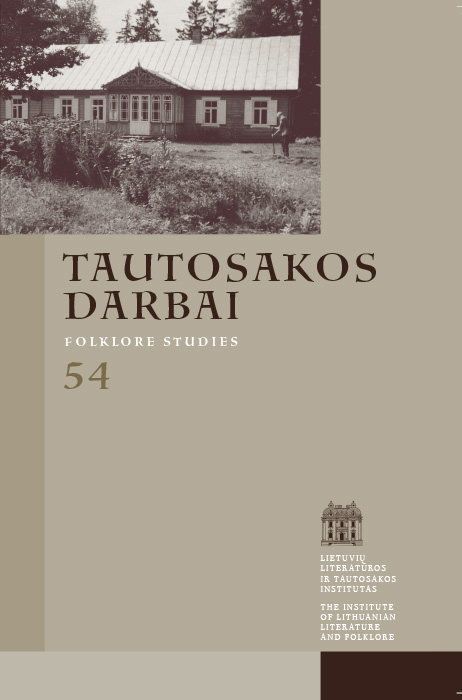Symbolic Meaning of Ring as a Grave Good in the Samogitian Burials
Abstract
This article falls in the realm of ethnoarcheology – a branch of archeology, resting on an analogy of the cultural continuity applied in it: analyzing and comparing archeological and ethnographic materials in terms of the same cultural context. The analyzed data of the ring comes from the Samogitian cultural region.
The analyzed archeological material is from pre-Samogitian and Samogitian burial sites of the 1st – 16th century. During this period, Samogitia was among those few archeological cultures that predominantly used inhumation. Inhumation graves allow establishing the placement of the grave goods in relation to the deceased, which is especially important for the analysis of the ritual providing the grave goods and its symbolic meaning.
The article also dwells on customs and verbal folklore from the Samogitian ethnographic region, comparing them to those coming from other regions. Folktales, folk legends and linguistic data from the academic “Dictionary of the Lithuanian Language” represent all the cultural areas of Lithuania.
In the 1st – 4th century Samogitia, ring as a grave good was used both for men and women, while in the 5th – 12th centuries rings were most frequently placed into the graves of men. From the 13th century, the situation altered again: rings became typically female grave goods. In the graves, rings are most frequently found on the deceased person’s fingers or on the breast, occasionally – alongside the body.
Both written sources and folklore depict rings as adornment of the young girls, who mostly wear a single ring, rarely – several ones.
To elucidate the symbolic meaning of the ring, the author of the article uses images that are especially prominent in folktales. Ring is primarily analyzed as a personal memento, also – as a personal sign and means of establishing and strengthening the relationships. The ritual of giving the ring as a present reveals its multiple meanings. The presented ring immediately becomes the memento of the person who gave it, and is associated with its giver. Certainly, the ring ties two people together, supporting and guarding this connection.
All the above-mentioned aspects are important in the funeral context too. Rings served as the memory of the living for the dead, or vice versa – of the dead for the living. Ring was regarded as a token – significant when meeting each other after death in search of the close ones or relatives. Placing of the ring into the grave could have been used to establish or strengthen the connection between the living and the dead.
Nine graves from the mediaeval and modern times supply data regarding the ring fingers. No rings were found on the thumbs of the deceased; they were most frequently wearied on the middle finger and on the ring finger, rarely – on the index finger and only once – on the little finger. The actual choice of the finger must have depended on the mythical meaning attributed to the hand and fingers.
Downloads
Most read articles in this journal
- Jūratė Šlekonytė, Lithuanian Fairy Tale “Bearskin” (ATU 361): European Context and Local Peculiarities , Tautosakos darbai: Vol. 66 (2023): Tautosakos darbai
- Modesta Liugaitė-Černiauskienė, Folk Ballad beyond the Genre Definition , Tautosakos darbai: Vol. 63 (2022)
- Vita Džekčioriūtė-Medeišienė, Mythical Notion of the Children’s Diseases and Their Liminal Expression in the Traditional Lithuanian Worldview , Tautosakos darbai: Vol. 64 (2022)
- Vilma Daugirdaitė, “Since Then, People Started Thinking about This Mountain in a Different Way”. From Jonas Kumetis’ Memories about the Veliuona Hillforts , Tautosakos darbai: Vol. 64 (2022)
- Kostas Aleksynas, Rita Balkutė. Galia užburti (kenkimo magija 1982–2012 metų įrašuose), Vilnius, 2013 , Tautosakos darbai: Vol. 47 (2014)
- Larysa Lukashenko, Musical Culture of Podlasie: Change, Transformation, Assimilation , Tautosakos darbai: Vol. 59 (2020)
- Bronė Stundžienė, The Lithuanian Folk Couplets: On This Side of the Permissible Laughter and Beyond , Tautosakos darbai: Vol. 59 (2020)
- Jūratė Šlekonytė, A Hundred Years of the Lithuanian Folktale Research: from the Traditional Comparativism to the Modern Methods , Tautosakos darbai: Vol. 49 (2015)
- Daiva Vaitkevičienė, “Užkalbėjimas”, “žadėjimas”, “vardijimas”: Outlining the Emic Terminology , Tautosakos darbai: Vol. 67 (2024): Tautosakos darbai
- Lina Leparskienė, Tatars by the Vokė River: Historical Memory and Personal Experiences , Tautosakos darbai: Vol. 63 (2022)




